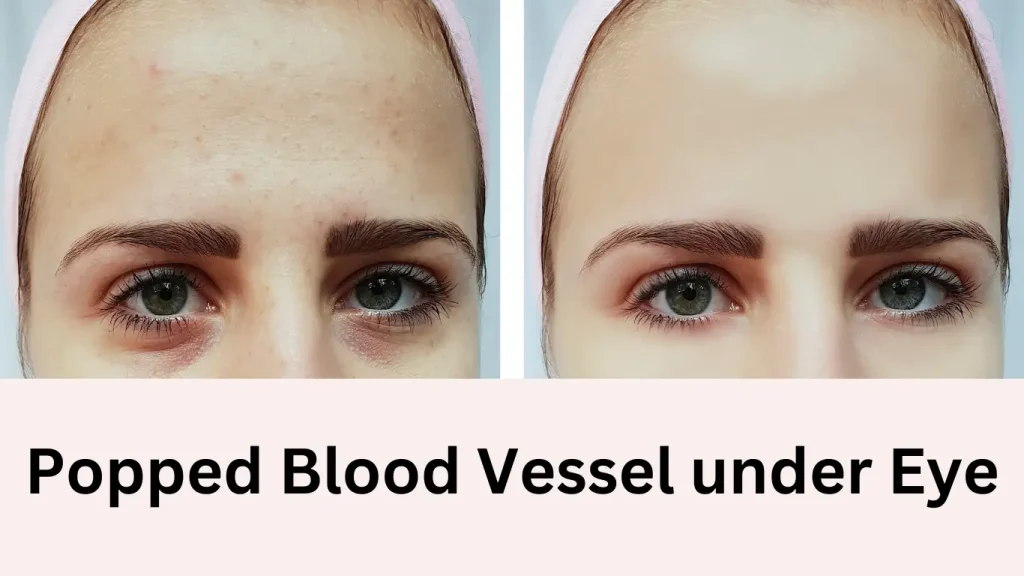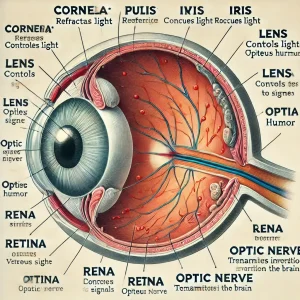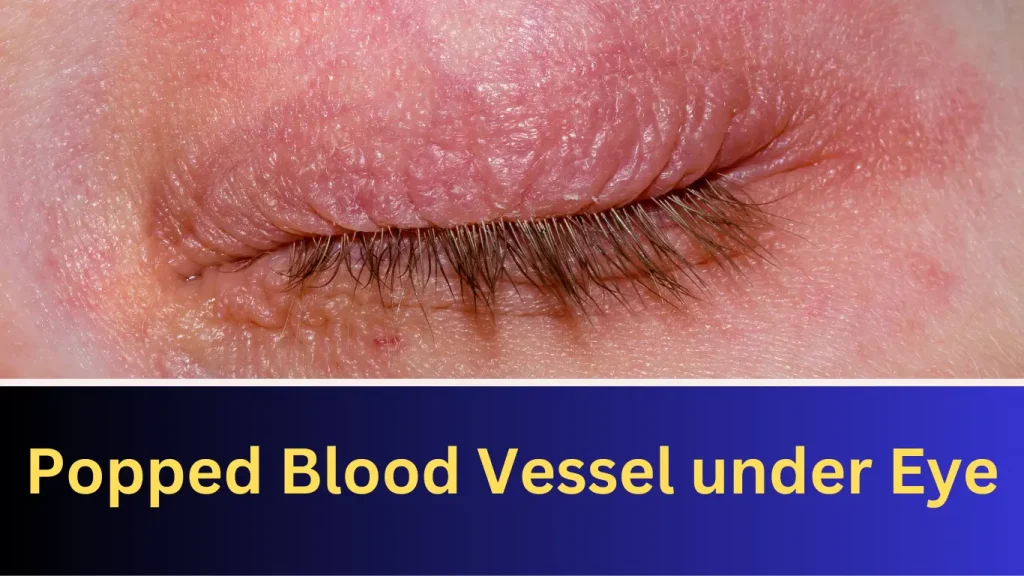A popped blood vessel under eye, also known as a subconjunctival hemorrhage, is usually harmless and can heal independently.
When first noticed, a popped blood vessel under the eye can be startling, giving the appearance of a bloody eye without any pain. These subconjunctival hemorrhages happen when a tiny blood vessel breaks just beneath the surface of the eye’s clear lining, called the conjunctiva.
While the exact cause may vary, common triggers include coughing, sneezing, straining, or eye rubbing. The condition is generally benign, with most instances resolving without treatment within two weeks. It’s recommended to monitor for discomfort, vision changes, or if the redness persists, in which case consulting an eye doctor is wise. As a visible health condition, it often generates concern, but it’s essential to understand that it’s usually not indicative of a serious health issue.

Introduction To Subconjunctival Hemorrhage
A sudden, striking red patch on the white of the eye can be quite alarming. This phenomenon is often a subconjunctival hemorrhage, a benign condition where a tiny blood vessel bursts beneath the clear surface of your eye (the conjunctiva). Though it may look serious, it’s usually a harmless event that resolves independently without treatment. Comprehending what a subconjunctival hemorrhage is, alongside the underlying anatomy of the eye, can help demystify this visually dramatic but commonly innocuous condition.
Defining Subconjunctival Hemorrhage
Subconjunctival hemorrhage occurs when the small blood vessels beneath the conjunctiva break, leaking blood into the space between the conjunctiva and sclera. This condition can result from a minor injury, sudden increase in blood pressure, heavy lifting, or coughing. It could also appear without any recognizable cause. Most importantly, it’s typically not associated with any serious health issues and tends to clear up without medical intervention.
Understanding The Anatomy Of The Eye
The human eye is a complex structure meticulously designed to capture light and convert it into signals that the brain can interpret as images. Key components, such as the cornea, iris, lens, and retina, work in harmony to provide vision. The conjunctiva is a transparent layer that covers the white part of the eye (the sclera) and lines the inside of the eyelids. It helps keep the eye moist and protected from dust and other foreign matter.
The outermost layer consists of the cornea and sclera; The middle layer contains the main blood supply of the eye and anteriorly consists of the choroid, ciliary body and iris.

Prevalence And Demographics
Subconjunctival hemorrhage can occur in individuals of all ages but is more commonly observed in adults over the age of 50. Factors such as high blood pressure, diabetes, and anticoagulant medications can increase the likelihood of experiencing this condition. Despite its startling appearance, it is not contagious and does not impact vision. Data about its prevalence are not precise, but the condition is not rare and crosses all demographics, affecting both genders equally and showing no particular preference for any specific group.
Learn more about Oxygen Popped Blood Vessel in Face in the main guide.
Learn more about Oxygen Broken Blood Vessel on Nose in the main guide.
Learn more about Ruptured Blood Vessel in Leg in the main guide.
Causes And Risk Factors Of A Popped Blood Vessel
A popped blood vessel under the eye, known medically as subconjunctival hemorrhage,
can appear as a conspicuous red spot on the white of your eye. Despite often causing concern due to its appearance, it is typically a harmless condition and resolves without treatment. Understanding the
causes and risk factors is essential to manage and prevent recurrent episodes comprehensively.
Changes in blood pressure: Sudden extreme changes in blood pressure can cause small blood vessels to swell. An exceptionally hard sneeze or vomiting can cause this change in pressure. Rosacea: People with some types of rosacea may experience spider veins and skin flushing as symptoms.
Common Causes Of Subconjunctival Hemorrhage
The causes of a popped blood vessel in the eye may vary from the benign to the serious. Here are some common triggers:
- Physical Strain: Activities such as heavy lifting, vigorous coughing, sneezing, or vomiting can increase pressure in the blood vessels, causing them to rupture.
- Trauma: A direct blow to the eye, rubbing the eye with force, or wearing contact lenses can rupture the eye.
- Eye Surgeries and Medications: Certain procedures and medications that affect the eyes may cause hemorrhage as a side effect.
Identifying Risk Factors
Some individuals may have a higher likelihood of experiencing a subconjunctival hemorrhage due to various risk factors:
- A history of blood vessel fragility or recurrent hemorrhages.
- Older adults often experience changes in blood vessels, increasing susceptibility.
- High blood pressure can contribute to the weakening of blood vessel walls.
Interaction With Medications And Supplements
Certain medications and supplements can predispose an individual to bleeding events, including in the eyes. These may include:
| Medication Type | Effects |
|---|---|
| Anticoagulants | Reduces blood clotting and increases bleeding risk. |
| NSAIDs | May interfere with platelet function, leading to easier bleeding. |
| Herbal Supplements | Some, like ginkgo biloba, have blood-thinning properties. |
Connection To Medical Conditions
Various medical conditions can also lead to a popped blood vessel. Identifying and managing these is crucial.
They include diabetes, high blood pressure, blood clotting disorders, and immune system weaknesses.
It is advisable for individuals with subconjunctival hemorrhage to consult their healthcare provider for a thorough exam to rule out underlying health concerns.
Symptoms And Diagnosis Of Subconjunctival Hemorrhage
The sudden appearance of a red patch on the white of the eye can be both alarming and unsightly. This condition, known as a subconjunctival hemorrhage, often prompts questions about its causes, symptoms, and the necessary steps for diagnosis. Though it might look severe, it’s usually harmless. Understanding the symptoms and gaining a timely diagnosis is key to managing this eye condition effectively.
Recognizing The Symptoms
The primary indicator of a subconjunctival hemorrhage is a visible red or bloodshot area in one portion of the white of the eye that does not cover the entire sclera. Often, this condition is discovered when looking in a mirror or by someone else noticing. The symptoms typically include:
- A red area on the white of the eye
- No pain associated with the redness
- No discharge from the eye
- No change in vision
Despite the dramatic appearance, most individuals with a subconjunctival hemorrhage experience no discomfort and no interference with their vision.
When To Seek Medical Attention
Time to consult a doctor is necessary if you experience any of these conditions:
- Severe or recurring bloodshot eyes
- Presence of pain or discomfort
- Changes in vision, such as blurriness
- Blood in the eye, alongside other injury, like trauma to the head or eye
It’s important to determine whether the bleeding is due to a subconjunctival hemorrhage or another more serious condition.
Diagnostic Procedures And Tests
To confirm a subconjunctival hemorrhage, medical professionals may perform the following:
- Physical examination of the eye
- Review of medical history for any related conditions or blood-thinning medications
In cases with unclear causes or recurrent episodes, additional tests may include:
| Test Name | Purpose |
|---|---|
| Blood pressure measurement | To rule out hypertension as a cause |
| Blood tests | To check for blood disorders |
| Eye pressure test | To rule out glaucoma |
If a subconjunctival hemorrhage is confirmed, it usually resolves without treatment. Nonetheless, understanding the symptoms and obtaining the right diagnosis is critical to ensure that the condition is correctly identified and managed.
Treatment And Management
Discovering a popped blood vessel under the eye can be an alarming experience, yet it’s often not a cause for major concern. The delicate skin around the eyes is susceptible to the formation of subconjunctival hemorrhages, which typically heal on their own without any serious medical intervention. Nevertheless, knowledge of proper treatment and management is crucial to expedite recovery and mitigate any discomfort. The following are ways to treat and manage a popped blood vessel under the eye.
Popped Blood Vessel under the eye Treatment
Popped Blood Vessel under the eye Treatment,
You may want to use eye drops, such as artificial tears, to soothe any scratchy feeling you may be experiencing. Beyond that, the blood will absorb within about 1 to 2 weeks, and you’ll need no treatment.
Home Remedies And First Aid for Popped Blood Vessels under the eye
Home Remedies And First Aid for Popped Blood Vessels under the eye,
Immediate attention with some simple at-home measures can help reduce the redness and swelling associated with a popped blood vessel under the eye.
- Cool Compress: Apply a cold washcloth to the affected eye area for a few minutes at a time to help reduce swelling.
- Elevation: While sleeping, elevate the head with an extra pillow to decrease blood flow to the area, potentially reducing the severity of the redness.
- Gentle Cleansing: Maintain hygiene and avoid further irritation by gently cleansing the eye area.
- Avoid Rubbing: Refrain from touching or rubbing the eye, which can exacerbate the issue.
Medical Interventions
Medical Interventions,
Though home remedies can be effective, certain conditions necessitate professional medical intervention.
| Condition | Treatment |
|---|---|
| Persistent Pain or Discomfort | Consult a healthcare provider who may recommend an appropriate pain reliever. |
| Impaired Vision | Seek immediate medical attention to rule out any serious underlying issues. |
| Infection Signs | Antibiotics or other medications might be prescribed to tackle an infection. |
Monitoring and Managing Recurrent Cases
Monitoring And Managing Recurrent Cases
For individuals who experience recurrent cases of popped blood vessels under the eye, continuous monitoring and management are essential.
- Record occurrences to identify possible triggers like high blood pressure or physical strain.
- If over-the-counter solutions do not suffice, consult a dermatologist or ophthalmologist for advice on specialized treatments.
- Regular eye examinations ensure that any underlying health conditions associated with eye health are under control.
- Foods rich in vitamin C and bioflavonoids could potentially strengthen blood vessels, reducing the likelihood of reoccurrence.
Prevention And Long-term Outlook
Discovering a popped blood vessel under your eye might be a startling sight. Fortunately, though the appearance can be somewhat concerning, it’s usually not indicative of a serious health issue. Still, prevention is key to avoiding this condition, and for those who experience it frequently, considering long-term outlook and potential lifestyle changes can be beneficial. Read on to explore tips and strategies to prevent popped blood vessels and understand your prognosis.
Tips For Prevention
Protecting the delicate blood vessels around your eyes begins with everyday habits. Here are several proactive steps to minimize the risk of experiencing a popped blood vessel:
- Avoid excessive rubbing of the eyes to prevent irritation.
- Limit exposure to harmful irritants, such as smoke or harsh chemicals.
- Maintain a balanced blood pressure through a healthy diet and regular exercise.
- Ensure ample sleep and rest to avoid eye strain and fatigue.
- Wear protective eyewear during high-risk activities to shield your eyes.
Understanding The Prognosis
A popped blood vessel, medically known as a subconjunctival hemorrhage, usually resolves independently within one to two weeks. The blood trapped under the conjunctiva is absorbed back into the tissue, often without the need for treatment. However, recurring incidents warrant a visit to the ophthalmologist to rule out underlying conditions.
Regular check-ups and monitoring for any changes in eye health are vital in preventing future occurrences and ensuring that any potential complications are caught early.
Lifestyle Adjustments For At-risk Individuals
For those with a higher susceptibility to eye issues, including popped blood vessels, certain lifestyle adjustments can prove instrumental in reducing the frequency of such events:
- Manage chronic conditions such as hypertension or diabetes with close medical supervision.
- Hydrate consistently to maintain vascular health and avoid blood thickening.
- Integrate eye-friendly nutrients, like vitamin C and bioflavonoids, into your diet.
- Avoid alcohol excess and smoking, both of which can lead to vascular issues.
- Practice stress-relief techniques like yoga or meditation to reduce the likelihood of blood vessel ruptures due to stress.
Faqs And Misconceptions
Encountering a popped blood vessel under the eye can be a concerning experience. However, it’s often not as serious as it appears. To help ease your worries and provide clear information, we will address commonly asked questions and correct some prevalent misconceptions. This segment aims to enhance your understanding and guide you in identifying when professional advice is necessary.
Addressing Common Questions
When a tiny blood vessel bursts beneath the thin skin of your eyelid, it causes a subconjunctival hemorrhage. This section tackles the most frequent inquiries concerning this condition:
- What are the signs? Look for a bright red patch on the white of your eye.
- What causes these hemorrhages? They can result from sneezing, coughing, straining, or injury.
- Is treatment necessary? These hemorrhages usually heal on their own without the need for treatment.
- Can I prevent it from happening? While not all causes are preventable, avoiding eye rubbing and wearing protective eyewear can help.
Dispelling Myths About Subconjunctival Hemorrhage
Misinformation can often lead to unnecessary anxiety. Let’s clear up some common myths:
| Myth | Fact |
|---|---|
| It’s an indication of a life-threatening condition. | Most often, it’s not associated with serious health issues. |
| It will lead to permanent vision damage. | The condition doesn’t typically affect your vision and clears up without long-term effects. |
| It is the same as a “red eye” caused by infection or inflammation. | Unlike infections that can cause a red eye, a subconjunctival hemorrhage is usually confined to one area and not associated with discharge. |
| It requires immediate medical intervention. | Although alarming in appearance, it often resolves without medical treatment. |
Knowing When To Consult A Professional
While many cases of subconjunctival hemorrhages are harmless and self-limiting, there are instances where you might need medical advice. Note these signs:
- Persistence beyond two weeks: If the red patch doesn’t improve, seek an evaluation.
- Recurring episodes: Frequent hemorrhages could signal an underlying condition.
- Accompanying symptoms: If you experience pain, vision changes, or discharge, consult an eye care provider.
Remember, prioritizing your eye health and staying informed are key steps to managing such incidents confidently and cautiously. Google Maps
Frequently Asked Questions On Popped Blood Vessel Under Eye
How Do You Get Rid Of Broken Blood Vessels Under Your Eyes?
To reduce broken blood vessels under your eyes, use laser treatments, apply retinoid creams, or consider gentle IPL therapy. Consult a dermatologist for safe and effective options tailored to your skin.
How Long Does A Popped Blood Vessel Last?
A popped blood vessel, or subconjunctival hemorrhage, typically heals within 10 to 14 days without treatment.
Can Eye Blood Vessels Pop From Stress?
Yes, stress can lead to the bursting of eye blood vessels, known as subconjunctival hemorrhage. This condition often heals on its own without treatment.
What Are The Blood Vessels Below The Eye?
The blood vessels below the eye are primarily capillaries, along with some small veins and arteries. These vessels support ocular function and skin health.
Conclusion
While alarming, a popped blood vessel under the eye is often not a cause for serious concern. Managing stress, protecting the eyes, and maintaining a healthy lifestyle can prevent future occurrences. If symptoms persist or for peace of mind, always consult a healthcare professional.
Remember, eye health is a vital part of overall wellness.
